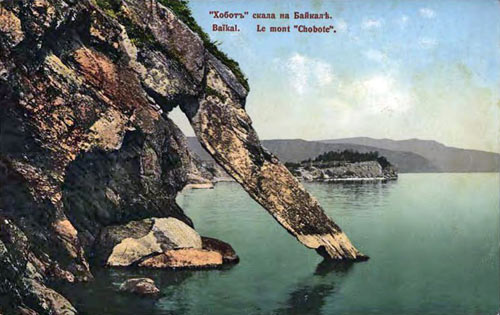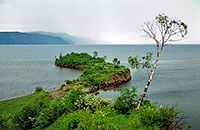Cape Shamansky (AikhaвҖ“Shulun) and Khobot cliff
History was such that at and around Baikal there are quite a number of В«shamanВ» designationsВ вҖ” Shamansky Rock at the source of the Angara, Shaman Cliff on Olkhon and two whole Shaman Capes: one in the northвҖ“east of Baikal, the other at its southernmost end. It is the latter Cape Shaman situated in Kultuk Bay that is described here.
AikhaвҖ“ShulunВ вҖ” Strashny Kamen (fearful rock)В вҖ” was how the Buryats called this cape, one of the most striking at Baikal. According to legend, a very long time ago, a shaman was buried in the cape's cave. Perhaps this is the reason why the cape was considered sacred and served as a place where sacrificial and religious rituals were performed. Later, Russian merchants used to stop at the cape, thinking that veneration of the shaman would improve trade. With time, the Russian name В«ShamanskyВ» stuck to the cape. Since then the cape became well known in the scientific world thanks to the investigation of Benedict Dybovsky and Victor Godlevsky.
One of the sights in the vicinity of Cape Shaman was Khobot cliff: washed away rock strata at the base of the cliff disappearing obliquely into the water. The Khobot (trunk) was so striking that, in days gone by, postcards were produced depicting it. Local people believed that it was sufficient to pass through the hole in the rock in order to rid oneself of sickness.
 Khobot cliff
Khobot cliffAt Baikal there are few such cliffs illustrating the action of waves: two on the western coast, near Peschanaya Bay, two on the eastern side not far from Malaya Cheremshanaya brook, one on the eastern coast of Olkhon and another on the island of Bolshoy Ushkany. And В«Khobot» вҖ” near Cape Shaman. But now there is no Khobot: someone was in great need of lime and they blew Khobot up.
Considerable damage was caused to Cape Shaman by the rise in water level brought about by the building of the Irkutsk hydroelectric power station. The cape itself underwent intense abrasive reformation and the waveвҖ“formed caves were destroyed at their foundations.
At one time, one of the most beautiful of Baikal's capes, whose rocks gave refuge to numerous colonies of seals, is now a sorry sight. A few generations of tourists lost no time chopping down anything and everything that would burn. In the middle of the last century the cape was covered completely by forest. The few seal that still visit Baikal's southern parts have forgotten the route to Cape Shaman...
В© Magic Baikal

